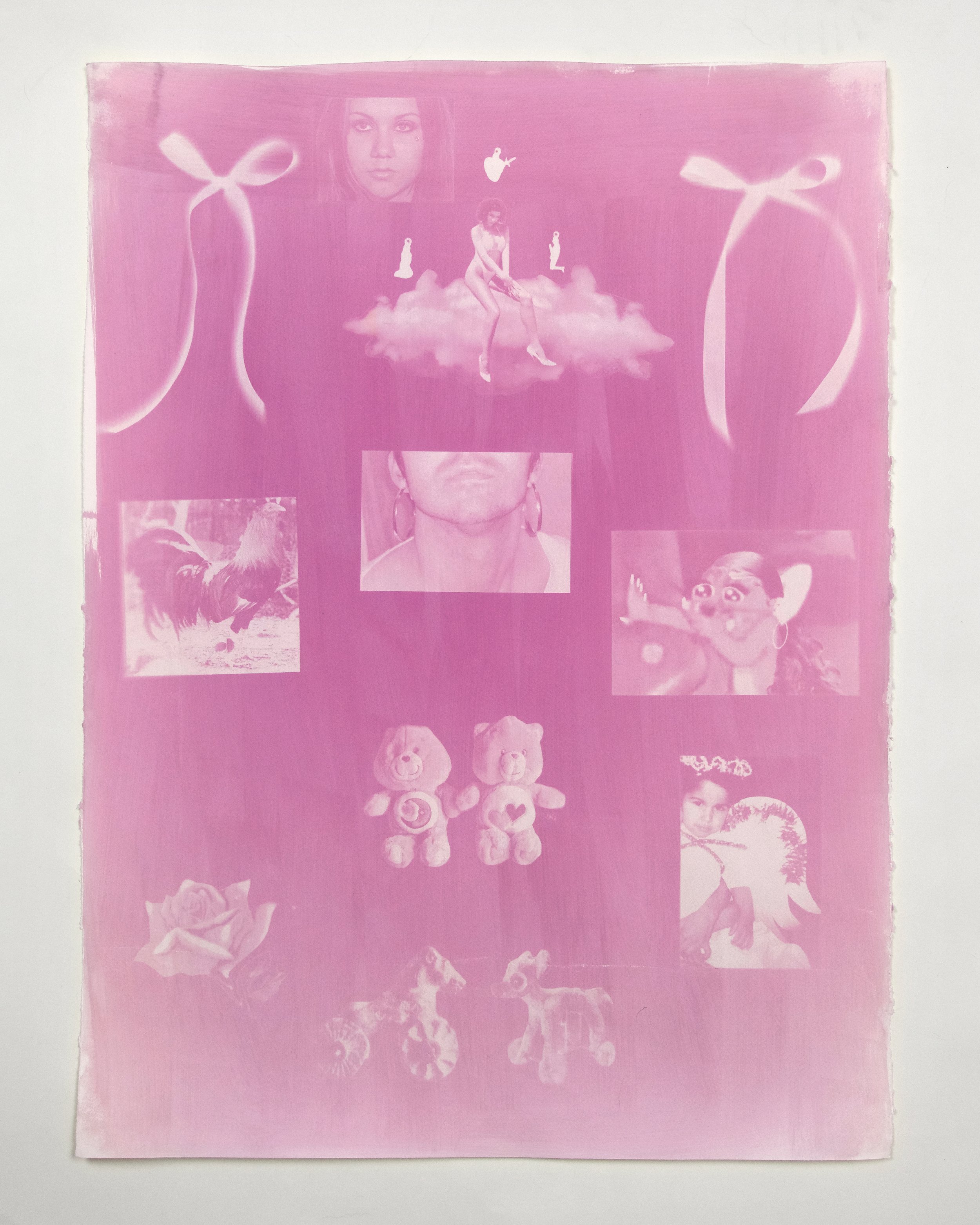HYPER FEMME
January 27 — March 9, 2024
Opening night: Saturday, January 27, 6-9pm
With Lynny’s open late
Music by Malika
Drinks by Marfa Spirit Co
Hyper Femme explores what it means to present yourself as “ultra feminine” in a world where femme bodies are considered consumable and expendable. Femme expression is generally thought as women's default form, rather than an actively constructed identity. This show explores femme as a term that's claimed, rather than accepted, as not just foil to the masculine (whether of men or of the femme-butch dyad), but as an exclamatory statement of self, a hyper-performance of gender, a giggle that's in on the joke.
Dahlia Bloomstone, Levi Dugat, Cam McCafferty, and Elena Isabel Pena explore the symbology of femmeness through relics, dress, and gender presentation. Femme expression stems from a multitude of different places (queerness, joy, comfort, desire) while actively resisting societal pressure to conform to narrow, capitalist-driven ideals of femininity.
Hyper Femmetakes what she wants and leaves the rest behind, meeting the femme on her terms, in her myriad forms. Sex bomb, clown, saint, crone: we worship you all.
Dahlia Bloomstone
Dahlia Bloomstone (b.1995) is a Puerto Rican/American artist and Hunter College MFA (NY, 2022) graduate with a BFA from Bard College (NY, 2018). Bloomstone has exhibited with 205 Hudson Gallery (NY), Rhizome (NY), Millennium Film Workshop (NY), Do Not Research (NY), Hauser & Wirth (NY), CICA Museum (ROK), and had a recent show at Hyacinth Gallery (NY). Dahlia’s work is also affiliated with the White Columns Gallery (NY) artist registry. She is the recipient of the SPCUNY Actionist grant from the Mellon Foundation, the Master’s Thesis grant from Hunter College, the Ox-Bow CIP scholarship, and a Skowhegan School of Painting and Sculpture fellowship. She has participated in residencies through the School of Visual Arts, Ox-Bow, and Foreign Objekt and recently attended the Skowhegan School of Painting and Sculpture. She was a Visiting Artist/Adjunct Professor at UTAustin in 2023 and has forthcoming performances at Hyacinth Gallery in New York in 2024. Dahlia lives and works in New York.
Dahlia Bloomstone has developed a body of work rooted in video, which has evolved to encompass animation, sculpture, AI, code, video games, film, and performance. Dahlia attempts to address and reconcile representations of exchange, domesticity, fragility, joy, social value, and mutual aid, often through the lens of sexual commerce, absent or under-theorized in the art canon. Dahlia’s work surveys the technologies, economies, and ecologies around the social value and social implications of both online and IRL sex work (SW) and investigates the paradigm shifts in these economies. Her work employs metaphoric language, often using fish as vehicles to embed conversations of intertwined ecologies. She delivers stories to speak through concurring socio-political and economic issues and is constantly renegotiating her relationship to these concepts within the panoptic discourse on the (her) internet. Her projects push beyond metaphor by researching methods of extraction and care for fish. Her work asks whether we can understand and navigate these systems, environments, and exploits of sex work and labor and systems of care. Her work concludes that SW is an enduring, pervasive, timeless construct that has and will always exist even after reimagining multiple adjacent worlds.
Levi Dugat
Levi Dugat was born and raised in East Texas by folks who worked with their hands and taught him to do the same. He does a little bit of just about everything and whole lot of designing interiors, furniture and textiles. Much of his artistic work, like his life, is focused around the pursuit of the present moment, personal activism, communal healing, and authenticity. He lives and works just outside of Austin, Texas on 12 wild acres with his daughter and his partner. He has shown work in Austin, Houston, Portland, and San Francisco.
For Hyper Femme, Levi Dugat installs a reimagined department store cosmetic counter, displaying a full line of beauty products, fashioned from an impractical mix of clay, wood, paper, and resin. Each product is painstakingly designed to preserve, protect and restore various elements of his femininity and identity. The products’ gaudy, faux mass-produced and outmoded branding shines a flickering vanity mirror light on an intersection of working class femininity, embodied by a male transsexual, and the struggle to deflect capitalism’s timeless mission to define healing as a consumer good.
Cam McCafferty
Cam is a genderfluid, Asian-American comic artist and zine maker. Their work has been described as “sometimes silly, sometimes deeply touching.” They are interested in intricate depictions of queer characters of color, magic, transformation, and flawed romance.
Elena Isabel Pena
Elena Hernandez-Pena (b. 1992, San Antonio, TX) is an artist based in San Antonio, Texas. She studied photography at the Santa Fe University of Art and Design, and has since focused her practice on alternative developing utilizing diverse materials and techniques. Exploring themes that shed light on pressing cultural issues affecting Latine and working-class communities in the United States, Elena seeks to capture the resilience and fragility of life across cultures and sociaeconomic strata.
From my earliest memories, my culture has been a purveyor of a pre-packaged image of femininity. From the sultry mexican weather girls on Telemundo to the busty women emblazoned with the Tecate logo during the boxing matches I would watch with my Dad on Showtime. In adulthood, social media echoes stereotypes, reducing the diversity of Mexican femininity to simplistic archetypes. The journey to find my own expression of femininity and reclaim my sexual agency has been a personal hellscape because of societal expectations and imposed identities. Within this struggle, there is empowerment- a reclamation of the spicy Latina trope, turned on its head and transformed into a symbol of self-expression.
The work uses imagined imagery of saints, found photographs and objects, and personal snapshots to join together the sacred and the earthly. These works, adorned with irony, hyper-sexuality, and femininity, delve into the dual nature of the feminine mystique. These pieces act as a catalyst for public discourse, carrying the viewer to confront the external forces that shape our perceptions of femme expression. It is my hope that these pieces spark conversations about the intricacies of identity, encouraging a collective reevaluation of the narratives that influence our understanding of FEMME.


